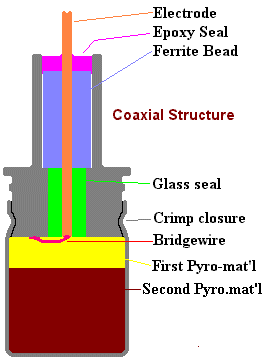MJMcCann Consulting

Objective
 The task was to develop a design method that would make sure that small ferrite filters would prevent the transfer of dangerous amounts of energy into pyrotechnic devices. In principle the idea is simple, a test on a single ferrite bead gives an indication of its inductance and with the resistance of the circuit, an estimate of attenuation or filtering effect is made.
The task was to develop a design method that would make sure that small ferrite filters would prevent the transfer of dangerous amounts of energy into pyrotechnic devices. In principle the idea is simple, a test on a single ferrite bead gives an indication of its inductance and with the resistance of the circuit, an estimate of attenuation or filtering effect is made.
However, the configuration allowed only a small amount of space for the ferrite material, the form was a coaxial line with non-standard conductor materials and the terminations were themselves other coaxial arrangements. To make it more interesting, the manufacturer's data for the properties of the material provided permeability values over only a small part of the frequency range specified. We were working to MILSTD 1576 or variants of it for commercial applications and needed to go well above the gyromagnetic resonance frequency of the material.
Approach
I developed a model of the device treating it as a small short, transmission line with the structure into which it led being similarly treated. As a result we had a model of a weird communications line. However for testing we could not actually look at the receiving end as that was the location of the pyrotechnic material and covered. So we used a vector signal analyser and measured the input impedance of the device over the range of frequencies we were interested in (only dummy pyro materials in place!) and with this plot, after a lot of jiggling about we were able to get a small signal model of the properies of the ferrite that were consistent with its initial permeability (known), the drop off above the gyromagnetic resonance frequency and some estimates of the loss component (complex permeability) beyond the frequency covered by the manufacturer's data.
Results
From the resulting model we could calculate small signal attenuation to be sure the amount of signal passing to the fuse wire (bridgewire) was low enough to be safe. However, that was all small signal stuff. The MILSTD 1576 specification (or variant thereof) called for significant input power to be put in by conjugate matching. As the power was applied, the ferrite bead absorbed it, heated up and changed its characterisitics. That never improved the matching so the power input was never thereby increased. Tests on live devices later showed the designs were safe. The live testing was another interesting experience especially as we did some deliberate tests (and two unintentional ones!) to find out what safety margin we really had.
Home/Index Page
About Dr McCann
Summary
Dr M.J.McCann
Training Courses
Bristol University
Contacting me
Contact in UK
Location USA
Philosophy
Software Tools
Fees
Confidentiality
Business & Commerce
TV Advertising
Drugs Competition
Housing Demand
Automobiles Demand
Wallcoverings Battle
Cash Flow
Human Resources
Project Management
Patent Analysis
Chemical Industry
Cooling Tower
Fermentation
Polymer Process
Heat exchange
Supercritical Fluid
Distributed parameter
Toxic gas allocation
Electrical
Control systems
Initiation systems
Ferrite Filters
Microstrip Antennas
Lightning
Production & Process
Automated manufacture
Crimp and Press
Glass making
Glass molding
Glass to metal seals
Heat exchanger
Helium Leak Testing
RF Soldering
Vacuum web coating
If you have a problem with the behaviour of a market sector, plant, process or item of equipment and would like to get a quantitative handle on it to improve yield or optimise performance, then contact me. I'm always ready to give a little time to discuss a new puzzle, in confidence, of course. We'll only worry about fees when there is some defined work. I can be flexible about how I work with you.
Top
POB 902,
Chadds Ford PA
19317 USA.
T: 1 302 654-2953
M: 1 302 377-1508 (Cell)
E: mjmccann@ieee.org
File: FerriteFilter.htm
 Applications
Applications